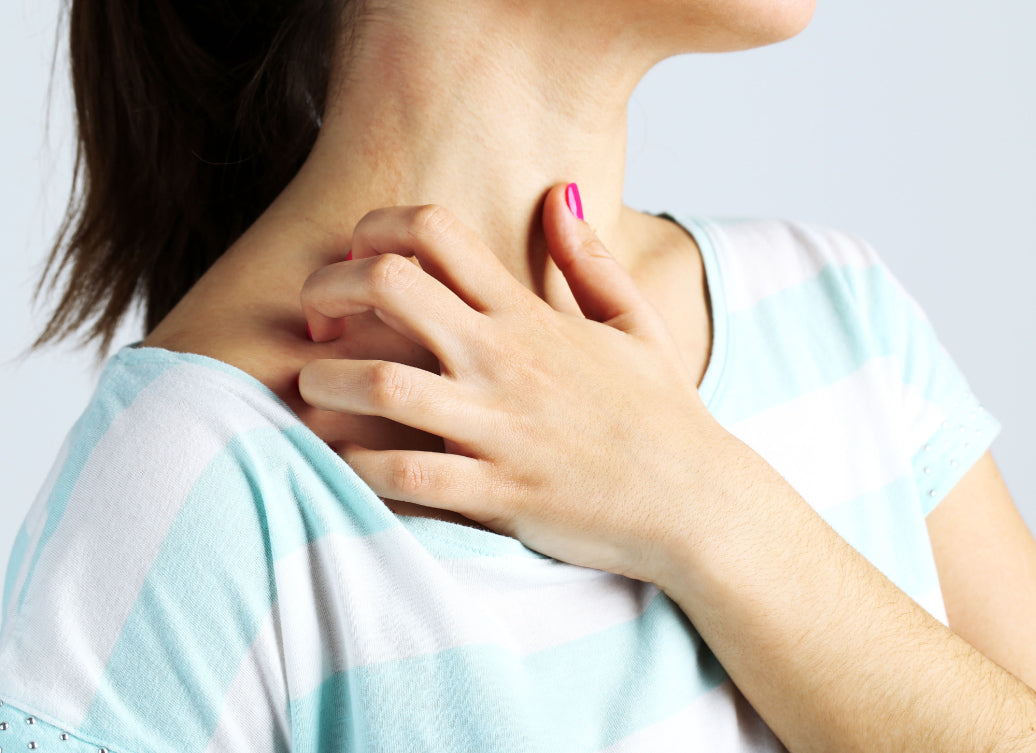Simply put, polymorphic light eruption (also known as PMLE) is when the skin reacts to sunlight; it can manifest in a variety of ways - bumps, spots, plaques, rashes and discolouration - but the common feature is that the skin affected has been exposed to sunlight (albeit sometimes through thin clothing).
Why does it happen? Well, that’s still out for debate! Although dermatologists know something about the mechanism whereby UV light causes the skin to flare, it’s a bit of a mystery why some people are affected so badly, and others aren’t affected at all.
For more information about who tends to get PMLE, when it occurs, and what it looks like, see our article What Is Polymorphic Light Eruption?
PMLE can be a really frustrating condition for those who suffer with it; while in mild cases the rash can be just a temporary inconvenience, in severe cases the rash can be intensely itchy, blistered and feel burning and sore to the point of distraction. It can also cause psychological distress to sufferers, as the rash tends to be on newly exposed areas of skin - the neck, upper chest and arms; areas that have been covered up during the winter, for example - and can seriously affect self-confidence.
One of the main issues with PMLE is that it tends to occur all of a sudden, on the first hot day or the year, or the first day of a much-needed holiday. While the problem only lasts a few days for some, for others rashes and itchiness persist for as long as the weather is bright and warm.
So what can be done about it? Although the condition can’t be ‘cured’ as such, sufferers do have a few options for managing it.
Leave it
The first option, in very mild cases of PMLE, is simply to do nothing and let it run its course. Sometimes it’s not worth seeking medical treatment for something that will resolve itself within a few days, though of course it entirely depends on how severe an effect the condition is having on your life.
Oral antihistamines
You may find over the counter antihistamines help soothe the itching; you may need to try more than one type before finding one that works for you.
Cold compresses
Press a cold, damp cloth against affected skin. You could also try ‘ice towels’, microfibre cloths which are used to cool down after exercise, or cool gel packs kept in the fridge.
OTC pain relief like paracetamol
If the itching and soreness is really debilitating, a pain reliever might help. Ask your pharmacist for the best type for you.
Keep out of the sun
Avoid getting sunshine on your skin when it’s at its height - between 10am - 3pm for example - by staying inside, or limiting your exposure as much as possible.
Sunscreen
Apply a high factor, broad spectrum sunscreen before you go outside; find a non-irritant brand and make sure you cover all exposed skin thoroughly and reapply during the day.
Clothing
Cover exposed areas with tightly-woven fabric (skin can be affected by PMLE through light layers) to protect your skin if you do go outside.
Topical corticosteroids
In some cases, GPs might prescribe a short course of steroids to calm down the inflammation caused by PMLE. This is a short term solution, as steroid creams can have serious side-effects, so best used by people whose PMLE is short-lived, rather than cases where it persists all summer.
Natural desensitisation
This strategy aims to get your body used to UV light by gradually increasing the dose of sunshine you get day by day. It has a similar effect to the natural consequences of your skin getting used to the sunshine over time, as spring then summer progresses, but is a deliberate version! The idea is to raise the skin’s resistance to sunshine bit by bit, and involves exposing your skin for just a short while each day, then covering up with sunscreen/protective clothes for the rest of the day (being careful not to burn in that short time, obviously).
UV desensitisation
In cases where PMLE has a seriously debilitating effect on people’s lives, doctors might prescribe a course of photo-desensitisation in early spring; this is a course of brief exposure to UV light in a cubicle, which aims to boost your skin’s natural resistance to the problematic sunlight, gradually hardening the skin so that it doesn’t react as severely in the summer.
Vitamin D
If you’re avoiding sunlight during the summer, it could be necessary to supplement with vitamin D. Talk to your doctor or pharmacist about your options!
You might find Balmonds emollients useful to help keep your itchy skin in good, healthy, resilient condition. Although creams and balms cannot ‘cure’ or treat the root cause of PMLE (or other chronic skin conditions), they are effective at providing hydration, locking in moisture, smoothing thickened areas, and keeping skin soft and supple.
Our products do not contain sunscreens! Do not apply oils or oil-based balms like Skin Salvation to exposed areas of skin in bright sunlight, as the oils can make the skin more likely to burn.
Recommended products:
Balmonds Skin Salvation
with hemp and beeswax
Balmonds Daily Moisturising Cream
with shea butter and calendula
Balmonds Cooling Cream
with shea, menthol, aloe vera & lavender
